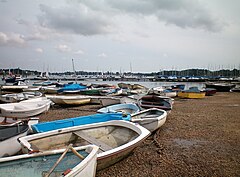|
West Itchenor
West Itchenor is a village and civil parish, on the Manhood Peninsula, in the Chichester District of West Sussex, England. It lies north of the B2179 Chichester to West Wittering road 4.5 miles (7.3 km) southwest of Chichester. The village lies on the shores of Chichester Harbour. The parish covers an area of 413 hectares (1020 acres). According to the Office for National Statistics, based on the 2011 Census estimates, 289 people lived in 140 households, of whom 122 were economically active. 99.7% of residents were White and 76.5% identified as Christian.[1] Since the desertion of East Itchenor in the 15th century, the village has been simply referred to as Itchenor.[2][3] West Itchenor was an ancient parish of the county of Sussex. Until 1894 it formed part of Manhood Hundred, an ancient division of Chichester Rape. From 1894 to 1933 it was part of Westhampnett Rural District. From 1933 to 1974 it was part of Chichester Rural District, and since 1974 it has been a part of Chichester District. HistoryA settlement is thought to have been established during the Roman conquest of Britain in AD 43, however the area was one of the first to be resettled by the South Saxons when they colonialised the south coast. West Itchenor takes its name from the chieftain Icca, who laid claim to its shoreline, and was originally known as Iccanore ('Icca's shore'). The Domesday Book of 1086 names the village as Icenore,[4] with six households,[5] and notes that the land was held by Warin, a vassal of "Earl Roger" who invaded England with William the Conqueror.[6] In 1187 it was called Ichenore,[7] and by 1243 Westichenor.[8] The manor later became a parcel of the Earl of Arundel.[9] In 1175 the Lord of the Manor Hugh Esturmy built a chapel in West Itchenor, adjacent to the River Haven; prior to the construction of a sea wall and sluice in 1931, a spring tide would cause the river to rise and surround the building. Between 1180 and 1197 the chapel became a parish church dedicated to St Nicholas, the patron saint of seafarers. The population of West Itchenor diminished during the Black Death which swept England from 1348, yet the village survived. East Itchenor was part of the contiguous parish of Birdham but was never more than a mansion with around 100 acres of farmland although it did have its own chapel. The latter's subsequent decline in the following century culminated in its unification with Birdham in 1440. Towards the end of the 19th century, West Itchenor became a popular destination for Londoners who could afford a second home in the countryside and the cost of travelling there. These people, known locally as 'DFLs' (Down from London),[10] have caused the rapid growth of the village since that time. However, despite the increased number of households, the number of full-time and economically active residents has fallen, as house prices have increased with the demand for second homes. This in turn caused the closure of the general store and post office in 1974 and of the local village school.[11] The Itchenor Society estimated in 2012 that over 40% of all households were second homes.[3]  During the Second World War, Itchenor Shipyard served as a base for the Admiralty's manufacturing of Fairmile B motor launches and Itchenor Sailing Club was requisitioned by the British Army, which mounted an anti-aircraft gun at the club to attack approaching Luftwaffe planes. This wartime activity made West Itchenor a restricted area and required residents to produce identification papers as they entered the village.[3] EconomySince the 1700s shipbuilding has provided the main source of employment in the village – West Itchenor was the site of a prominent shipyard during the Napoleonic Wars in which a number of warships were launched, such as HMS Pelorus in 1808 and HMS Curacao in 1809.[12] In 1800 the Transit, a 101 ft long, four-masted barquentine weighing 200 tons, was built at the yard and is said to have been revolutionary in the design of its hull and rig. During the 19th century construction began to decline, as the development of railways provided a more accessible mode of transport. Shipbuilding in West Itchenor made a modern revival with the opening of Haines Boatyard in 1912. In 1936 a new yard, called the 'Itchenor Shipyard' was built on the site that had seen production during the 18th and 19th centuries.  Northshore Yachts Ltd now occupies the site of the Itchenor Shipyard and has overseen the complete manufacturing of Fisher and Southerly yachts, since the mid-1970s.[13] In April 2013 it was reported that Northshore was experiencing financial difficulties and that the future of the boatbuilding company and its estimated 160 employees is in doubt.[14] PoliticsWest Itchenor Parish Council sits seven elected members, with elections taking place every four years. In representing the people of the parish, the councillors meet monthly to discuss matters including planning, community engagement and finance. West Itchenor falls under The Witterings electoral division which returns one member to sit on West Sussex County Council. The village also falls under West Wittering electoral ward which returns two members to sit on Chichester District Council. It is a part of the Chichester constituency, which has been a safe Conservative seat since 1924. This was the case until 2024 when Jess Brown-Fuller of the Liberal Democrats won the seat. Landmarks
Notable residents

GalleryWikimedia Commons has media related to West Itchenor.
References
|
||||||||||||||||||||||||||||||||||||||||||||





